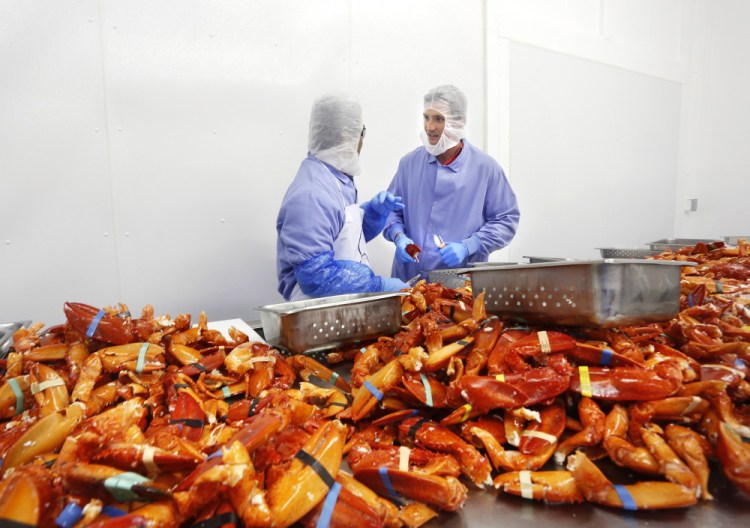The state’s most ambitious marketing campaign yet to stoke global appetite for Maine lobster is now underway. But thanks to the efforts of a fresh-faced 30-year-old from Cape Elizabeth, the state’s signature seafood may not be such a hard sell.
Since opening his first Luke’s Lobster restaurant in October 2009, just two years out of college, Luke Holden and his partners have made the $15 Maine lobster roll into a sought-after delicacy for foodies in New York, Washington, D.C., and Philadelphia.
The 13 locations – which are furnished with lobster traps and buoys and serve up native brands such as Hurricane Soups and Gifford’s Ice Cream – have attracted a raft of acclaim from the likes of The New York Times, Wall Street Journal, Bloomberg Business Week, GQ and The New Yorker. The young entrepreneur has landed on 30 under 30 lists compiled by Forbes and Inc. magazine and Zagat’s survey.
But even as Holden burnishes the crustacean’s reputation hundreds of miles from Maine’s rocky shores, he has become more deeply entrenched in local efforts to fortify the industry that employs hundreds of Mainers and has an estimated $1 billion economic impact in the state each year.
In December 2012, Holden and his brother Bryan opened Cape Seafood, a processing plant in Saco, to supply his restaurants, and in so doing created up to 125 local jobs during the peak of the season. And last year, Luke was tapped to join the boards of the Lobster Institute and the Maine Lobster Marketing Collaborative.
“Luke has a uniquely comprehensive understanding of the industry, great business acumen and has been very successful in marketing Maine lobster,” said Pat Keliher, commissioner for the Department of Marine Resources. “He has done an outstanding job of building awareness and appreciation for Maine lobster.”
A LOVE OF WATER
Holden fell in love with lobstering when he was 14, and spent his summers fishing even after graduating from Cape Elizabeth High School in 2003 and heading to Georgetown University, where he was captain of the school’s ice hockey team.
“I just loved the feeling that you get when you pull up that lobster trap and you don’t know what you’re going to get,” he said.
Even now, he goes fishing every chance he gets, waking at 4:30 a.m. and setting out with a rod and reel on the 16-foot wooden skiff he built in high school to catch the sunrise and the still waters and possibly dinner.
“It just completely brings me back to center,” said Holden, who bought a house in Biddeford with his brother, and splits his time between Maine and Manhattan. “It’s just very peaceful.”
At Georgetown, Holden majored in finance and management and interned with investment banking giant UBS. That led to a job with Cohen & Steers Inc., a boutique firm that specializes in mergers and acquisitions in the real estate sector.
But for a Maine-bred boy who spent his formative years in the woods, on the water or at the hockey rink, the lifestyle of a New York investment banker was brutal. The first few years out of college were an endless loop of 16-hour workdays and six-day workweeks, little sleep and even less exercise.
And there was another hunger that he just couldn’t satisfy: a good lobster roll.
The food that had been ubiquitous to him growing up was out of reach; only available at white tablecloth restaurants, often overpriced with filler added to mask the poor quality of the product. Even in meals billed as lobster specialties “it was never the star of the show in terms of the flavor,” he said. “It was not what I grew up knowing in Maine, and it was not the way that the industry ultimately was going to grow.”
That’s when Holden started thinking about opening a place of his own. He partnered with Ben Conniff, a food writer from New England, and in October 2009, they opened a 300-square-foot lobster shack in Manhattan’s East Village. They kept the operation bare bones, writing the menu on a chalkboard and putting out eight stools for counter seating. Holden quit his job when they opened a second location on the Upper East Side in May 2010, and went on to open 11 more locations in New York, Washington, D.C., and Philadelphia.
His experience in banking – where he learned to break overwhelming challenges into bite-sized components to achieve a goal – served him well as he broke into the notoriously finicky New York food scene. Whether he was trying to find sites, employees, resolve mechanical and plumbing issues, map customer flow through the restaurants or navigate permitting morasses, “it was all the same idea, looking at a problem, trying to analyze how to get from where you are to your goal and beyond,” he said. “I really liked the process of figuring out how to break down a huge project into smaller parts and make it work within a team environment.”
And the formula worked. Even as other lobster shacks came and went, Luke’s Lobsters continued to attract long lines and kudos from the nation’s most influential tastemakers. His signature dish was lauded for its low price ($15) and simple preparation (cooked and chilled, with a little lemon butter, a modest swipe of mayo, a dash of celery salt and other secret spices). Whenever Luke Holden was interviewed, whether it was by a reporter for The Village Voice or by Kathy Lee Gifford on NBC’s “Today” show, he espoused the sweet taste of Maine lobster and sustainability of the fishing practices.
“The big separating factor for us has been how intimately involved we are in the sourcing process,” he said. “It defines our quality and our brand and enables us to offer a better product, tell a better story and offer a better customer experience.”
Holden plans to open two more locations in New York this year, and three to five new locations each year in the next five years. Ultimately he can foresee building up to 40 restaurants and venturing into cities such as Boston and Chicago. He said he likes knowing each restaurant’s managers and shift leaders, and does not want to lose the company’s family-friendly feel. And he’s made it a family operation. His brother Bryan is his business partner. His brother Mikey manages one of the New York locations.
Observers say that the time might be prime for Maine lobster, as foodies are craving healthy, eco-friendly food, and becoming more familiar with regional specialties.
“More consumers are looking for sustainability, farm-raised and locally grown attributes,” said Mary Chapman, director of product innovation with Technomic Inc., a Chicago-based research firm. “And a smaller but growing number of people are willing to pay a little bit more for those qualities. If a place delivers a high-quality and interesting product and a diverse enough menu, customers are going to come back.”
GIVING BACK
Even as Holden has brought lobster to diners beyond Maine, he’s deepened his investment inside the state’s borders.
In 2012, he and Bryan opened the processing plant in Saco with the help of a $200,000 loan from the Biddeford-Saco Area Development Corp. and a $500,000 equity investment from himself and his business partners.
The restaurants handle up to 5,000 pounds of fresh lobster meat each week, and they needed access to more product as the chain expands.
“There was no facility that could dedicate that kind of capacity to us,” he said. ”We realized that if we wanted to continue to grow and maintain our quality standards we were going to need a dedicated processing facility.”
In so doing, he joined a batch of new processors who have started in the past few years. The number of lobster processors in Maine has jumped from five to 12 since 2010. The 4.5 million pounds of lobster he expects to process this year puts him on par with the volume reported by Linda Bean’s processing operation, one of the state’s biggest in 2012.
Bolstering the local lobster processing industry – and having an economic impact in the state where they were raised – was a high priority for the Holdens.
State officials are hoping a $7 million bond referendum on the November ballot to expand lobster and other seafood processing will allow the state to keep processing revenue and jobs that have historically gone to Canada.
In 2013, Maine lobstermen caught 126 million pounds of lobster and Canada received an estimated 54 million pounds of it for processing.
“When you have the ability to process lobster in the state rather than shipping it to Canada it has a multiplier effect,” Holden said. “You’re putting money in Maine fishermen’s pockets, paying Maine lobster dealers, paying Maine truckers to drop off the product at your facility, using Maine workers to package the products and employing Mainers to process the product and supervise the process.
“That definitely feels good, and it’s something my partners and I feel most proud of,” he said.
Last year, Holden became more involved in local efforts to shore up the industry. He joined the Maine Lobster Marketing Collaborative, an 11-member board made up of lobstermen, dealers and public officials charged with promoting lobster around the globe. The group has a $750,000 budget funded by a surcharge on licenses issued to lobstermen, processors and dealers. He also joined the board of the Lobster Institute at the University of Maine, which works on conservation, outreach, research and education to sustain the lobster fishery.
“Because he’s at the end of the food chain – serving lobster to the customer on an everyday basis – and he has his own processing facility he has more than knowledge. He has an understanding that’s helped us all,” said Robert C. Bayer, executive director of the Lobster Institute. “He’s so dynamic, and he’s got such a unique way of seeing things, not just straight ahead but everything going on around him.”
Holden has made a concerted effort to showcase Maine-made products in his restaurants, and given brands like Greene-based Hurricane Soups, Shipyard Ale of Portland and Gifford’s Ice Cream of Skowhegan exposure to markets that they might not otherwise have.
“Being featured in Luke’s Lobsters had such a great impact on our company,” said Phil Wilbur, co-owner of Hurricane Soups, adding that the restaurants account for about 50 percent of their sales. Calls and emails pour in from people who have tried his products at Luke’s Lobster, he said. “They’ve had such tremendous growth, and that’s created opportunity for us.”
Send questions/comments to the editors.





Success. Please wait for the page to reload. If the page does not reload within 5 seconds, please refresh the page.
Enter your email and password to access comments.
Hi, to comment on stories you must . This profile is in addition to your subscription and website login.
Already have a commenting profile? .
Invalid username/password.
Please check your email to confirm and complete your registration.
Only subscribers are eligible to post comments. Please subscribe or login first for digital access. Here’s why.
Use the form below to reset your password. When you've submitted your account email, we will send an email with a reset code.